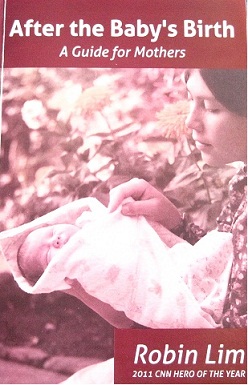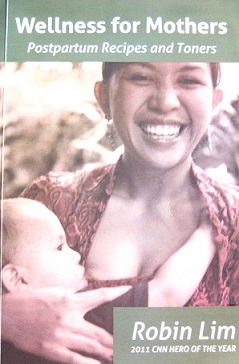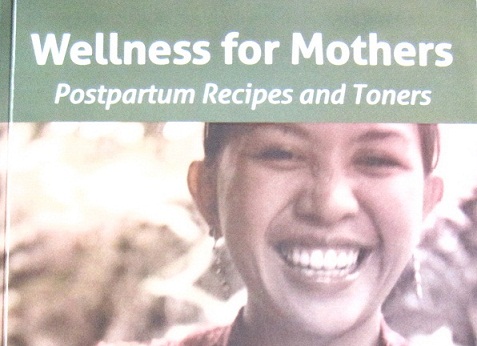By ELIZABETH LOLARGA
 IN the gentle gospel according to Robin Lim, a woman grows wise and grows young at the same time with every baby she bears.
IN the gentle gospel according to Robin Lim, a woman grows wise and grows young at the same time with every baby she bears.
Lim, CNN Hero of the Year in 2011, has just delivered twins, After the Baby’s Birth: A Guide for Mothers and Wellness for Mother: Postpartum Recipes and Toners (Anvil Publishing Inc.). In prose as soothing as her midwife’s hands, she has helped bring back the spiritual nature in birthing and nurturing a newborn, thus underscoring her conviction that world peace is possible “one baby, one mother, one family at a time.”
She addresses the reader in the familiar “you.” Even a post-menopausal woman or a man can feel her conviction, one that is specially empowering to a first-time mother and repeated in variations: “Who better to teach the world how to live gently and peacefully than postpartum women? Yes, this is in my opinion is each new mother’s exalted role: healer and teacher. Each of you postpartum mother reading this book can trust that nature has given you the knowledge and the tools to do a splendid job reinventing the world. Your lap, your kitchen is the classroom.”
The subtext is clear, although it isn’t meant to undermine modern medicine. Why unthinkingly hand over the lives of mother and child to a hospital when there are wholistic ways?
More doctors and hospitals have realized the time-honored wisdom of protecting the bonding process. More fathers are allowed in delivery rooms. Instead of isolating the baby in a nursery, rooming-in is possible in Filipino hospitals to facilitate breastfeeding, a practice that Lim hopes will become standard.
The chapter “Breastfeeding, Bottle-feeding and Breast Care” cannot be over-emphasized enough at a time when milk formula manufacturers have become more cunning in marketing.
Breastfeeding is universally accepted as best for babies. It is also best for mom. Among the reasons Lim cites, backed by medical literature, are it improves remineralization that prevents osteoporosis and the risk of hip fractures in later life, it hastens involution (the return of the uterus to its pre-pregnancy state), it reduces the risks of ovarian and premenopausal cancer.
The practical benefits include no strain on the family budget (formula remains expensive), no need to sterilize bottles and artificial nipples or lug around bottle-feeding gear.
 Lim answers all concerns like postpartum depression, engorgement, cracked or sore nipples, plugged ducts, breast lumps, how to store breast milk (useful for working or studying mothers), caring for the yoni (her preferred Sanskrit term for the vagina for it acknowledges the “sacred temple” inherent in a woman), when to resume lovemaking, etc.
Lim answers all concerns like postpartum depression, engorgement, cracked or sore nipples, plugged ducts, breast lumps, how to store breast milk (useful for working or studying mothers), caring for the yoni (her preferred Sanskrit term for the vagina for it acknowledges the “sacred temple” inherent in a woman), when to resume lovemaking, etc.
She suggests a retort a mother can give if she’s reprimanded for breastfeeding in public: “Don’t ask permission to nurse your baby. You are not doing anything unnatural or illegal…Don’t let others make you feel that you should nurse your baby in restrooms. If someone asks you to do this, ask them if they would like to eat their next meal in the bathroom.”
The chapter “Shared Stories” is heartfelt. Writing in the first person, parents tell of untiring demands of fussy, colicky babies, deciding to take time off from a law practice (“I’ll be a lawyer for the rest of my life. Amanda will only be a child for a few precious years.”), how Bach and Mozart restored a parent’s mastery over herself, giving up a baby for adoption born in one’s teens then being blessed with sets of twins at a more mature age, going through 12 pregnancies with only five children surviving, losing a husband to cancer a month before a baby is due, feeding a baby with a soft cleft palate with breast milk against all odds.
The companion volume, delicately and richly illustrated by Marcia Barnett-Lopez and Zion Lee, shows the different exercises recommended to tone a mother’s body. Listed and explained are the beneficial herbs and food that can both comfort and strengthen a mother.
Lim empowers her intended audience–women and mothers: “Your body belongs to you. Sculpt it as you wish, but treat it with kindness and love. You deserve to be physically beautiful by your own standards, not society’s…Don’t judge yourself by how you weigh when how you feel is what counts…[Y]our body is not you, but the vehicle you’ve been given with which to move through life.”
Lim’s heroism lies in bringing back the sacredness of birth. She culls from an Indian belief that “the events of a person’s life, from the present back to birth, pass before the eyes as one leaves the world…[I]t is recommended that the first sound the baby hears is the father’s or mother’s voice saying one of the names of God. This ensures that the person’s last earthly experience will be the name of God.”
